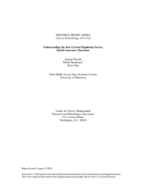
An official website of the United States government
Here’s how you know
Official websites use .gov
A .gov website belongs to an official government organization in the United States.
Secure .gov websites use HTTPS
A lock (
) or https:// means you’ve safely connected to the .gov website. Share sensitive information only on official, secure websites.
-
//
- Census.gov /
- Census Working Papers /
- Understanding the New CPS Health Insurance Questions
Understanding the New Current Population Survey Health Insurance Questions
Understanding the New Current Population Survey Health Insurance Questions
Introduction
The US Census Bureau’s Current Population Survey Annual Social and Economic Supplement (CPS) is the most widely cited and used source of estimates on health insurance coverage (Blewett and Davern, 2006). Well before health reform posed additional measurement challenges, many researchers were critical of the CPS because its estimate of the number of uninsured appeared too high. The chief evidence for this conclusion was that the CPS estimate, which defined the uninsured as those without coverage throughout the calendar year, was on parwith other surveys’ estimate of the number of uninsured at a point in time. By definition, theCPS, which defines a person as uninsured if they lacked coverage for every day in a calendar year, should estimate a smaller number of uninsured compared to a survey that defines uninsurance as lacking coverage on the date of interview (or any other specific point in time).The fact that these estimates are close led researchers to assume the CPS was missing out on reports of past coverage. Indeed, another persistent criticism of the CPS is that its calendar year estimate of the uninsured is higher than most other surveys that measure calendar year coverage. For example, in a comparison of major national surveys, estimates of the uninsured throughout calendar year 2012 were 15.4 percent in the CPS and 11.1 percent in the National Health Interview Survey (NHIS) (SHADAC, 2013).
Share
Some content on this site is available in several different electronic formats. Some of the files may require a plug-in or additional software to view.
 Yes
Yes
 No
NoComments or suggestions?


Top

